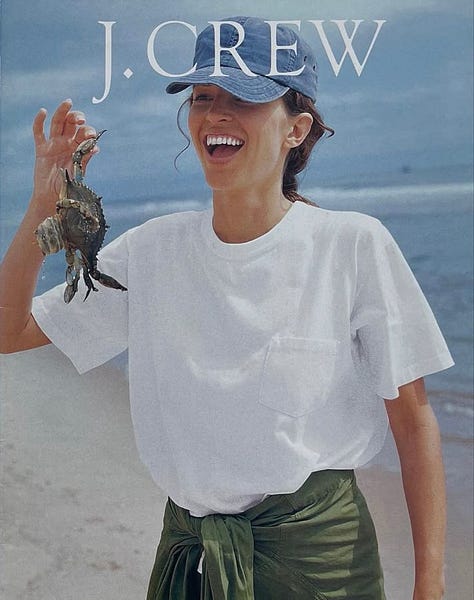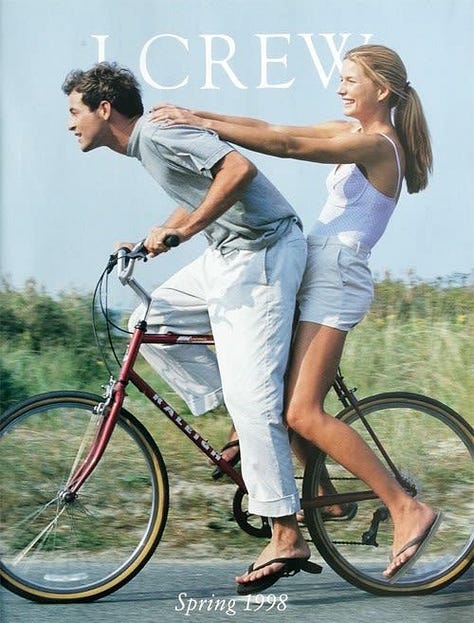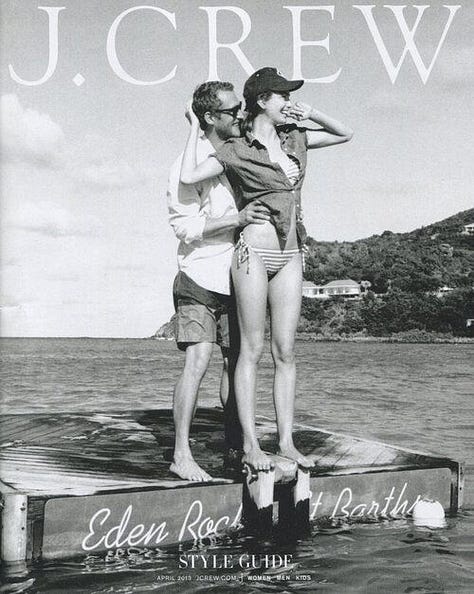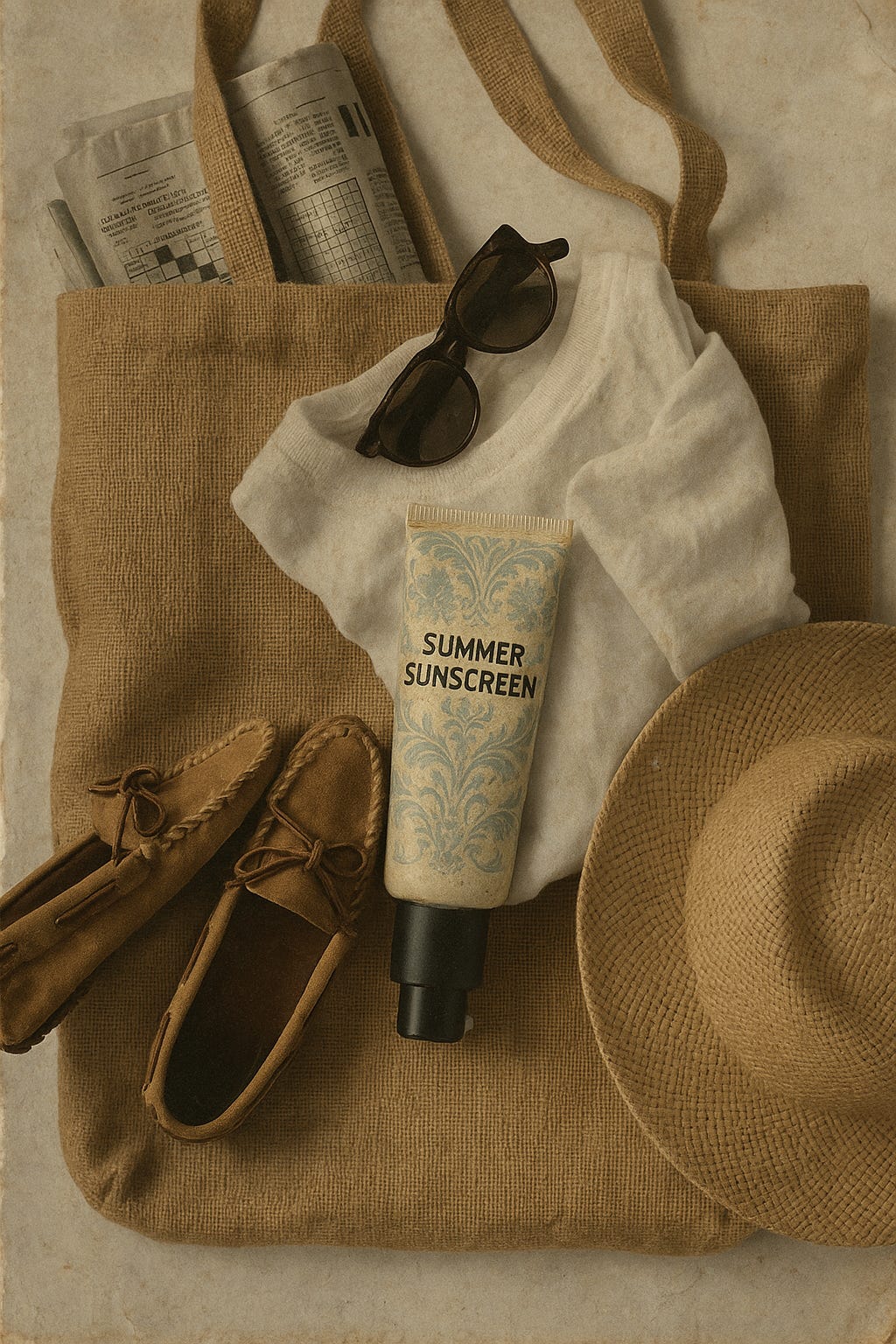Designing a Sunscreen at Home in a 90s J.Crew Ad
A cosmetic chemist + beauty product developer walks through how to formulate the sunscreen of a normcore daydream.
I usually daydream in skincare formulation. Most of the time, I don’t mentally formulate for anything practical—just playful musings. What would a face mask look like should Soundcloud drop a skincare line? What bubble bath formula might result should Loeffler Randal open a day spa? (It would definitely be an oil-based champagne and glitter gel to match the Rhys Jelly Sandals I’ve been eyeing).
This morning I day dreamt a bit more practically: I imagined a simple sunscreen designed to accompany yuppie summer adventures in Southampton.
I’ve previously formulated best-sellers for indie skincare startups and beauty CPG giants alike. I’ve worked in almost all parts of the beauty world, from personal assistant to co-founder as a cosmetic chemist, product development strategist, raw material expert, content creator, coffee getter, creative director, and now brand founder.
Here’s how I might design a sunscreen for the summer of my dreams. (For the beauty industry experts and formulation nerds, stay tuned—I’ll follow with a technical deep dive on exactly which raw materials I’d pick at first pass.)
The Inspiration
Pages from J.Crew catalogues of the 90s. That perfect cotton tee.



The Goal
Create a classic sunscreen lotion with even, transparent skin-melt, a crisp and dry finish, water resistance, and all-day wear. The idea isn’t to reinvent the wheel, but to perfect it—drawing on timeless formulation principles using minimal, no-fluff ingredients.
The Formulation Challenge
Seamlessly blend old-school ingredients with modern mineral dispersion and stability systems. This formula isn’t about chasing the newest, shiniest innovation—quite the literal opposite: let’s add shine and oil control to a sunscreen base formulated with time-tested ingredients.
Simplicity and elegance are essential. A few cheeky ingredient choices are welcome, but only if they honor the lessons of the past. In true normcore fashion, this project is about perfecting the precise use of closet staples to create a product that can be worn with effortless ease, every day.
Water resistance is non-negotiable—we’ll either be caught in a sudden summer storm while out riding our bikes, or spend all day at the beach.
The formula should be minimal (as long as it doesn’t compromise on function) and clean (in the purest, no-nonsense sense—no greenwashing). It should be unfussy and intentional. Preference goes to precise, technical, proven ingredients over trendy natural extracts and essences.
To Briefly Outline the Project:
Function: SPF 50+ for face and body.
Format: Classic water-in-oil lotion.
Texture: Lightweight and breathable—the perfect white tee (vs. the underlying serums and morning creams, which may feel closer to linen).
Application: Silk-like flow with easy skin-melt and no white cast.
Fragrance: None added.
Packaging: A simple squeeze tube, perhaps with a pump cap. Elegance over innovation here.
Formulation Method
Only a mineral sunscreen feels right for this project. I can’t put my finger on exactly why — perhaps it’s about honoring the classics. Let’s go with Zinc Oxide in a modern, elegant dispersion system. This means proven protection in an understated lotion base. After all, classics are classic for a reason.
To elevate and fine tune the texture, I’ll incorporate emollients that deliver a lightweight, crisp feel—nothing heavy or greasy. The lotion should glide on effortlessly and disappear with ease.
For added skin benefit, let’s build in oil control. It’s essential that this sunscreen helps us stay chic and fresh all day. Getting overly oily simply won’t do. Plus, this detail sets us apart. While some sunscreens might highlight DNA repair enzymes or trendy antioxidants, we’ll quietly integrate these technologies where they make sense—an effective dose of peptides, enzymes, and antioxidants to help support broad-spectrum UV protection and repair from photo-damage, without distracting from the marketed goal: a daily staple, a reliable companion for summering in the Hamptons. Understand elegance is key. So is oil control, both in the formula and on our face.
Fragrance: None added. This may leave a slightly “oily” scent—subtle and characteristics of a mineral base—but that’s intentional. It leaves space for more important personal scents: the wearer’s chosen perfume and novel of the moment. (Régime des Fleurs Himitsu and Louis Auchincloss’ Diary of a Yuppie for me.)
The sunscreen will be applied first thing in the morning, tossed in the tote, and carried all day for touch ups. By evening, it’s rinsed away with a luxurious après-sun shower oil, a project for a future edition of this series.
Concluding Thoughts
In reality, product development is much more detailed. From here, we’d dive into a wealth of data to establish the formula’s raison d’être:
How does this SKU fit into the full brand portfolio?
Does it align with the brand’s product development thesis?
Is it a natural extension—or a marked departure?
What are the competitive products?
What do consumers love or hate about those formulas?
What claims are competitors making? Should we echo them, or stake out our own stance?
This process means examining everything from customer demographics and psychographics to user frustrations, favorite features from reviews, purchase behaviors, social trends, pricing, packaging, and fill weight considerations (among others).
I believe the best beauty products start with a story—imagining exactly how the target user falls in love with the product.
From there, you ensure that the idea has a strong business case and develop the technical thesis, long before benchwork begins.
It’s a sad reality that not all of these steps are always taken.
For those interested in a deeper dive—a raw material-by-raw material approach—I’ll follow shortly with a full technical breakdown.
I hope you all have the loveliest summers—just don’t forget to wear sunscreen! (Now I’m thinking I should also follow this up with my definitive ranking of sunscreens for summer 2025—the ones that actually exist).
Ciao!





